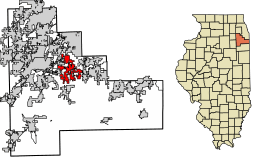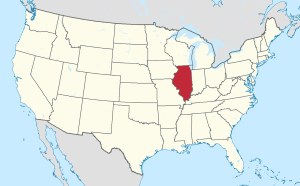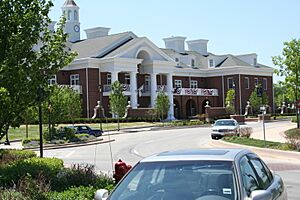New Lenox, Illinois facts for kids
Quick facts for kids
New Lenox
Village of New Lenox
|
|||
|---|---|---|---|
|
|||
| Motto(s):
Home of Proud Americans
|
|||

Location of New Lenox in Will County, Illinois.
|
|||

Location of Illinois in the United States
|
|||
| Country | United States | ||
| State | Illinois | ||
| County | Will | ||
| Incorporated | 1946 | ||
| Area | |||
| • Total | 15.76 sq mi (40.81 km2) | ||
| • Land | 15.73 sq mi (40.73 km2) | ||
| • Water | 0.03 sq mi (0.07 km2) | ||
| Population
(2020)
|
|||
| • Total | 27,214 | ||
| • Density | 1,730.29/sq mi (668.08/km2) | ||
| Time zone | UTC-6 (CST) | ||
| • Summer (DST) | UTC-5 (CDT) | ||
| ZIP code |
60451
|
||
| Area codes | 815 and 779 | ||
| FIPS code | 17-52584 | ||
New Lenox is a village located in the middle of Will County, Illinois, United States. It's a suburb southwest of Chicago. In 2020, about 27,214 people lived here. New Lenox is home to schools like Lincoln-Way West High School, Providence Catholic High School, and Lincoln-Way Central High School.
Contents
Village History
The first European settlement in the New Lenox area was called Van Horne Point. It was located near the intersection of US-30 and Gougar Road. New Lenox Township was created in 1852. This happened when Will County was formed and the Chicago, Rock Island and Pacific Railroad main line was built.
The town was first named Tracey. This was to honor the general superintendent of the Rock Island Railroad. Later, John van Duser, the first Rock Island Line supervisor for New Lenox Township, renamed it. He chose the name New Lenox after his hometown, Lenox, New York. The Village of New Lenox officially became a village on October 4, 1946. F. Carlton Cole, Walter Baers, and 44 other community leaders helped make this happen.
Early Settlers and Growth
In 1829, fur traders Aaron Friend and Joseph Brown set up a trading post. It was along the north side of Hickory Creek, near today’s Gougar Road. This was one of the first settlements in Will County. After the Black Hawk War in 1832, Friend moved west.
In 1830, William Rice Sr. and William Rice Jr. arrived. They started farming and built a log cabin. They later sold their land and cabin to John Gougar for his father, William Gougar. In 1832, "Uncle Billy" Gougar opened a post office on his farm. This farm became the main center of activity in the area.
Joseph Norman opened the second sawmill in the area in 1833. His daughter, Elizabeth Norman, was born in 1832. She was the first child born in New Lenox Township. The arrival of the Rock Island Railroad in 1852 greatly changed the area. Before the railroad, farmers had to transport their goods long distances. They used the I & M Canal or wagons to reach cities like Chicago. The railroad made it easier to send goods to distant markets. It also brought more visitors and mail. Later, three more railroads crossed New Lenox Township. These were the Wabash, the Michigan Central, and the Elgin, Joliet and Eastern lines. Over time, the area east of Gougar Crossing, along the railroad tracks, became the new town center. This is how the Village of New Lenox began.
The village was officially mapped out in 1858. The first map showed the name Tracy. This was to honor the railroad superintendent. However, Tracy asked for a different name. The first supervisor for New Lenox Township, J. Van Duser, had named the Township New Lenox. He named it after his hometown, Lenox, New York. In 1863, the settlement officially became New Lenox, just like the Township.
Important People and Innovations
H. N. Higinbotham was a very important citizen around the year 1900. Even though his home was in New Lenox, he became famous in Chicago. He was a partner in Marshall Field's, a banker, and a key organizer. He helped plan and supervise the World's Columbian Exposition of 1893. He was friends with many Chicago leaders, including George Pullman and Marshall Field. Mr. Higinbotham once owned the farms that later became Pilcher Park. He also ran one of the largest flower businesses in the area, growing carnations and roses.
In 1898, New Lenox got the first rural Bell telephone company in Illinois. By 1905, 132 people had phones. The telephone operators worked from their homes. This allowed them to provide 24-hour service for emergencies. The first switchboard was located in the Deadmore home at 221 Haven Avenue.
New Lenox is known as "The Home of Proud Americans." This motto shows the good quality of life in the community.
Village Geography
New Lenox is about 36 miles southwest of downtown Chicago. Its exact location is 41°30′30″N 87°58′14″W / 41.50833°N 87.97056°W. In 2010, the village covered about 15.68 square miles. Most of this area, about 15.66 square miles, is land. Only a small part, about 0.023 square miles, is water.
New Lenox shares borders with several other towns. Joliet is to the northwest. Ingalls Park is to the west. Mokena is to the east. Frankfort is to the southeast. Manhattan is to the south.
Local Climate
The average temperatures in New Lenox change throughout the year. In January, the average is 21 °F (-6 °C). In July, it's 73 °F (23 °C). On average, there are 137 days each year when the temperature drops to freezing or below. There are also 86 days when the temperature goes above 80 °F (27 °C).
| Climate data for New Lenox | |||||||||||||
|---|---|---|---|---|---|---|---|---|---|---|---|---|---|
| Month | Jan | Feb | Mar | Apr | May | Jun | Jul | Aug | Sep | Oct | Nov | Dec | Year |
| Record high °F (°C) | 65 (18) |
73 (23) |
88 (31) |
92 (33) |
96 (36) |
104 (40) |
103 (39) |
102 (39) |
99 (37) |
91 (33) |
78 (26) |
71 (22) |
104 (40) |
| Mean daily maximum °F (°C) | 30 (−1) |
35 (2) |
47 (8) |
60 (16) |
72 (22) |
81 (27) |
85 (29) |
82 (28) |
76 (24) |
64 (18) |
48 (9) |
35 (2) |
60 (15) |
| Daily mean °F (°C) | 21 (−6) |
27 (−3) |
46 (8) |
48 (9) |
60 (16) |
69 (21) |
74 (23) |
66 (19) |
64 (18) |
47 (8) |
39 (4) |
27 (−3) |
49 (10) |
| Mean daily minimum °F (°C) | 13 (−11) |
19 (−7) |
28 (−2) |
37 (3) |
48 (9) |
58 (14) |
63 (17) |
61 (16) |
53 (12) |
41 (5) |
31 (−1) |
20 (−7) |
39 (4) |
| Record low °F (°C) | −27 (−33) |
−20 (−29) |
−8 (−22) |
7 (−14) |
24 (−4) |
35 (2) |
40 (4) |
39 (4) |
28 (−2) |
17 (−8) |
−2 (−19) |
−25 (−32) |
−27 (−33) |
| Source 1: www.intellicast.com | |||||||||||||
| Source 2: myforecast.co/bin/climate.m?city= 15361&zip_code=60451 | |||||||||||||
Population and People
| Historical population | |||
|---|---|---|---|
| Census | Pop. | %± | |
| 1950 | 1,235 | — | |
| 1960 | 1,750 | 41.7% | |
| 1970 | 2,855 | 63.1% | |
| 1980 | 5,792 | 102.9% | |
| 1990 | 9,627 | 66.2% | |
| 2000 | 17,771 | 84.6% | |
| 2010 | 24,394 | 37.3% | |
| 2020 | 27,214 | 11.6% | |
| U.S. Decennial Census | |||
In 2010, the census showed 24,394 people living in New Lenox. There were 8,000 households and 6,547 families. The population density was about 2,425 people per square mile. There were 8,244 homes, with an average of about 820 homes per square mile.
Most residents, 96.2%, were White. About 0.8% were Asian, and 0.7% were African American. People of Hispanic or Latino background made up 5.7% of the population.
Out of 8,000 households, 45.2% had children under 18 living there. Most households, 69.8%, were married couples. The average household had 3.04 people, and the average family had 3.41 people.
The average income for a household in the village was $88,778. For families, the average income was $97,752. As of August 31, 2023, the average home value in New Lenox was $401,997.
Experts once thought New Lenox's population would grow to over 90,000 by 2030. However, growth slowed down. A 2015 estimate suggested the population would reach about 68,000 residents by 2040.
Local Economy
New Lenox had plans for two big shopping and business areas. These were called Cedar Crossings and Spring Creek Outlets. They were planned near the crossroads of I-355, Route 6, and Cedar Road. Cedar Crossings was meant to be a large retail center. Spring Creek Outlets would have been a big outlet mall. Both projects were delayed due to economic reasons.
However, in 2023, New Lenox announced a new plan. A 100-acre sports complex opened in June 2025. It is located where Cedar Crossings was first planned. This complex has nine full-size baseball fields and twenty-two youth baseball/softball fields. It also includes eleven multi-purpose fields, two batting cages, and a playground. There is also a 50,000-square-foot fieldhouse. This project cost about $70 million for the land and $50-60 million for the sports complex itself. Ten acres near the hospital and sports complex are also being sold for hotels and restaurants.
Village Government
New Lenox has a village form of local government. It uses a Council-Trustees/Mayor system. A village administrator helps manage the daily operations. The current mayor is Tim Baldermann. The village administrator is Kurt Carroll.
The mayor and six board members are elected by the community. They serve four-year terms. The board of trustees makes village policies and laws. They also oversee the village's planning. The current board members are Katie Christopherson, Amy Gugiliuzza, Keith Madsen, Lindsay Scalise, Bryan Reise, and Jim Wilson.
The village clerk is a hired position. This person keeps all official village documents. They also handle local elections. The village administrator makes sure all village rules are followed. They also recommend new employees and manage all village departments.
In 2007, the village government moved to the new New Lenox Village Hall. This building is about 65,000 square feet. The old Village Hall, which was about 14,000 square feet, was taken over by the New Lenox Police Department. The main floor of the old building was changed for police use. In 2014, a new building opened as the official Police Station in the Commons. This moved the police department out of the old Village Hall.
Community Culture
In 2005, the village opened the Commons. It features a Performing Arts Pavilion. The village hosts a Summer Performing Arts Program. This includes free concerts and family movie nights. Each summer, the village also has the Triple Play Concert Series. This series features national music artists. In 2024, it was announced that this series would be renamed the Summer Concert Series. The mayor said it would feature more famous artists and more concerts throughout the summer.
The New Lenox French Market started in 2011. It ran from late spring through October. It stopped after the 2015 season due to low attendance. However, the market made a comeback in 2025. It now runs on Thursdays from early May to mid-September.
New Lenox hosts several festivals. These include Cruise the Commons, Christmas in the Commons, Fridays After Five, and the Loyalty Day Parade.
Parks and Trails
The New Lenox Community Park District manages 40 parks and sports fields. These cover almost 600 acres. They also use 14 facilities around New Lenox.
New Lenox has many paved and gravel trails. The Old Plank Road Trail is 22 miles long. It's a paved trail for hiking and biking. It goes through the heart of New Lenox. You can access it from many points, including the Village Hall in the Commons.
The Hickory Creek State Nature Preserve has a 2.8-mile paved trail. It's for hiking and biking. It also leads to the historic one-room Schmuhl School Museum. This museum is owned by the New Lenox Historical Society. Additionally, the Hadley Valley Preserve offers a 4.85-mile crushed gravel trail. This Spring Creek Greenway Trail is open to walkers and horseback riders.
Important Infrastructure
Health Care Services
Silver Cross Hospital built a new $400 million hospital in New Lenox. It is located near U.S. Route 6 and the new I-355 extension. This new hospital replaced their old location in Joliet on February 26, 2012. The hospital offers services from Children’s Memorial Hospital, the Rehabilitation Institute of Chicago (RIC), and the University of Chicago Medical Center.
Train Transportation
New Lenox has two Metra commuter rail lines. The New Lenox Metra Station is at the corner of U.S. Route 30 and Cedar Road. It serves towns on Metra's Rock Island District Line. This line runs between Joliet Union Station and Chicago's LaSalle Street Station. New Lenox also has the Laraway Road Station at Cedar Road. This line is part of Metra's SouthWest Service Line. It connects Manhattan to Chicago's Union Station.
Major Highways
New Lenox is located where many major roads meet. U.S. Route 30 is the main east-west road through town. The major north-south roads are Cedar Road, Gougar Road, and Nelson Road. I-80 and I-355, also known as the Veterans Memorial Tollway, pass through New Lenox. These highways connect the village to other major roads and cities. These cities include Chicago, Joliet, Naperville, Wheaton, and Bolingbrook.
Education System
Elementary and middle schools in New Lenox are run by New Lenox School District 122. The Lincoln-Way Community High School District serves New Lenox and nearby communities. These include Frankfort, Mokena, Manhattan, and parts of Tinley Park.
There are three high schools in the district. Lincoln-Way Central and Lincoln-Way West are in New Lenox. Lincoln-Way East is in Frankfort. Providence Catholic High School is a private Roman Catholic high school located in New Lenox.
Local Media
New Lenox used to have a weekly community newspaper called The New Lenox Patriot. The company that ran the paper closed in April 2020 due to the COVID-19 pandemic. Now, most residents get their news from the New Lenox Patch website.
Notable People
Many interesting people have lived in New Lenox:
- B. J. Bello – An NFL linebacker who played for the Los Angeles Chargers.
- Alex Broadhurst – A former NHL center for the Columbus Blue Jackets.
- Adam Calhoun – An American rapper and songwriter.
- Karla DeVito – A singer and songwriter.
- Tony Cingrani – A former MLB pitcher for the St. Louis Cardinals.
- Ned Grabavoy – A former MLS player and current scouting director for Portland Timbers. He won the 2009 MLS Cup.
- Sonya Huber – A writer.
- Renée Kosel – A state Congresswoman representing Illinois' 81st legislative district.
- Rob Ninkovich – A retired defensive end and two-time Super Bowl champion for the New England Patriots. He is now an analyst for ESPN.
- Johan Reinhard – An Andean archeologist and explorer for National Geographic.
- Wellington J. Reynolds – A painter and instructor at the Art Institute of Chicago.
- Eric Steinbach – A retired NFL football player who played as an offensive lineman.
- Robert Francis Prevost (Pope Leo XIV) – The head of the Catholic Church.
Images for kids
See also
 In Spanish: New Lenox (Illinois) para niños
In Spanish: New Lenox (Illinois) para niños






